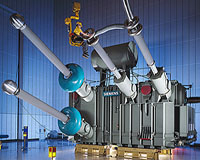 |
Braunschweig, Germany (SPX) Apr 21, 2010 At present, graphene probably is the most investigated new material system worldwide. Due to its astonishing mechanical, chemical and electronic properties, it promises manifold future applications - for example in microelectronics. The electrons in graphene are particularly movable and could, therefore, replace silicon which is used today as the basic material of fast computer chips. In a research cooperation, scientists of Leibniz University Hanover and of the Physikalisch-Technische Bundesanstalt (PTB) have now investigated in which way a rough base affects the electronic properties of the graphene layer. Their results suggest that it will soon be possible to control plasmons, i.e. collective oscillations of electrons, purposefully in the graphene, by virtually establishing a lane composed of projections and humps for them. The results were published in the current edition of the New Journal of Physics. The structure of graphene itself is fascinating: It consists of exactly one single, regular layer of carbon atoms. To manufacture this incredibly thin layer absolutely neatly is a great challenge. A possible method to recipitate graphene extensively on an insulating substrate is epitaxy, i.e. the controlled growth of graphene on insulating silicon carbide. For this purpose, a silicon carbide crystal is heated in vacuum. Starting from a specific temperature, carbon atoms migrate to the surface and form a monoatomic layer on the - still solid - silicon carbide. An important question for later applications is, how defects and steps of the silicon carbide surface affect the electronic properties of the graphene grown on it. Within the scope of a research cooperation between PTB and Leibniz University Hanover, the influence of defects in the graphene on the electronic properties has been investigated. During the investigations, special attention was paid to the influence of the defects on a special electronic excitation, the so-called plasmons. By different sample preparation, first of all silicon carbide crystals with different surface roughness and, thus, with a different concentration of surface defects were investigated, on which, subsequently, graphene formed. The influence of the defects on the plasmon excitations was then investigated by means of low-energy electron diffraction (SPA-LEED) and electron loss spectroscopy (EELS). The process revealed a strong dependence of the lifetime of plasmon on the surface quality. Defects, as they are caused on step edges and grain boundaries, strongly impede the propagation of the plasmons and drastically shorten their lifetime. Here it is remarkable that the other electronic properties of the plasmons, in particular their dispersion, remain largely unaffected. This opens up interesting possibilities for the future technical application and use of plasmons (the so-called "plasmonics") in graphene. By selective adjustment of the surface roughness, different graphene ranges could be generated in which the plasmons are either strongly dampened or can propagate almost unobstructedly. In this way, the plasmons could be conducted along "plasmon conductors" with low surface roughness specifically from one point of a graphene chip to another.
Share This Article With Planet Earth
Related Links Physikalisch-Technische Bundesanstalt (PTB) Powering The World in the 21st Century at Energy-Daily.com
 How Is Electrical Power Carried Across The Sea
How Is Electrical Power Carried Across The SeaBonn, Germany (SPX) Apr 13, 2010 Two trends are emerging for future renewable electricity. In the first, local solar, wind or biomass plants will produce more energy for small communities or single homes. In the second, large amounts of electricity will be generated by solar power stations in desert areas or extensive offshore wind farms, and delivered over long distances to densely populated areas. But how can electrical ... read more |
|
| The content herein, unless otherwise known to be public domain, are Copyright 1995-2010 - SpaceDaily. AFP and UPI Wire Stories are copyright Agence France-Presse and United Press International. ESA Portal Reports are copyright European Space Agency. All NASA sourced material is public domain. Additional copyrights may apply in whole or part to other bona fide parties. Advertising does not imply endorsement,agreement or approval of any opinions, statements or information provided by SpaceDaily on any Web page published or hosted by SpaceDaily. Privacy Statement |